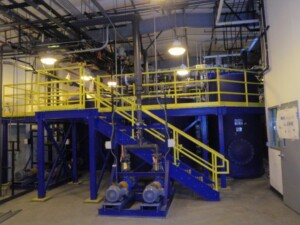Challenge
Los Alamos National Security’s (LANS) Los Alamos National Laboratory (LANL) discharges more than 175 million gallons of treated wastewater each year through 15 permitted outfalls under its National Pollution Discharge Elimination System (NPDES) permit. In order to meet the NPDES permit’s increasingly strict effluent limitations, LANL contracted with HDR to design and construct upgrades to the existing Sanitary Effluent Reclamation Facility (SERF) and infrastructure.
Approach
Under an integrated design-build delivery contract with LANL, HDR Constructors (HDRC) furnished qualified personnel, equipment, materials, and all design services necessary to design and construct the expansion of the SERF. This expansion allows LANL to reuse treated wastewater from the Sanitary Wastewater System (SWWS) at an expanded SERF and reusing it at various locations throughout the facility. Cooling towers at the Strategic Computing Complex (SCC) and Laboratory Data Communications Center (LDCC) receive treated effluent from the SERF facility. The SERF facility modifications included design and construction of a new building to house three micro filters and three reverse osmosis (RO) filters to clean up the SWWS effluent to a level that it can be reused. Facility modifications include associated site work and utility upgrades.
HDR’s scope of work included the following tasks:
- Expanding SERF to deliver 300 gpm for net processing capacity
- Expanding the treatment capacity of the existing SERF to allow treatment of the cooling tower blow down from the SCC, LDCC, and power plant
- Installing or modifying piping, lift stations, and/or other appurtenances necessary to convey SERF treated water to the SCC, LDCC, and power plant and SERF RO reject to the evaporation ponds
- Installing or modifying evaporation ponds to accept SERF RO reject
- Installing necessary influent, effluent, and blow down storage tanks
The facility design began in May of 2011 and by working closely with the LANL construction management personnel, HDR completed the project within the 14-month contract timeframe. Key to the successful execution of this project was the single-point of responsibility that the integrated HDR team provided. The HDR design and construction team worked closely with the LANL engineers to ensure that the project met all of LANL’s rigid requirements for both water treatment standards and construction standards.
HDR receives first-place ranking on the safety audit
Using behavioral-based safety concepts and employing a full-time safety professional on-site, HDR was able to manage 18 subcontractor companies through LANL’s stringent safety program. In the short time period at LANL, a positive safety culture was developed, which was a major reason the project was completed without a single first-aid incident or serious injury. In March 2012, DOE conducted an in-depth safety audit of construction projects performed at LANL. Of the 12 projects audited, the HDR LANL SERF project was given a first-place ranking on the audit, which reviewed all LANL contractor safety programs currently in place. Additionally, by attending and participating in LANL’s monthly safety meetings, HDR was able to assist in improving some of the LANL safety systems.
HDR receives excellent performance rating
Following project completion in September 2012, HDRC’s performance on this project received the highest rating possible, Level 5 – Excellent, in all nine review categories of the LANS Subcontractor Assessment Report, listed below:
- Safety Requirements
- Security Requirements
- Quality Assurance Requirements
- Adherence to Schedule
- Delivery Performance
- Technical Related Items
- Cost Management
- Subcontractor Management/Project Controls
- Business Related Activities
“HDR has been very responsive on the SERF project. They have worked diligently to meet our expectations.”
Chris Quartieri, LANL Project Manager


